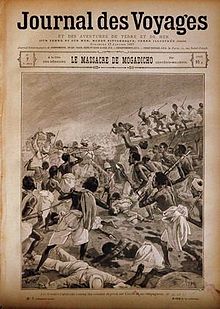Italian Somaliland
Zanzibar and Italian Somaliland bases within Somalia acquired from Italy |
Italian Somaliland ( Italian Somalia Italiana ) was an Italian colony in what is now Somalia . It comprised the south and the center of the country, while the north was a colony of Great Britain as British Somaliland .
Emergence
After the German East African Society (DOAG) had already raised claims to the entire Somali coast between Aluula and Buur Gaabo , the Italians took possession of the Somali areas from 1888 . In December 1888 they concluded a protectorate treaty with the Sultan of Hobyo against the Majerteen Sultanate of Bargaal , in April 1889 a protection treaty with the Sultan of Bargaal. 1892 forced Italy, the Sultanate of Zanzibar , which in the Somali Benadirküste under sansibarischer supremacy standing port cities Mogadishu , Merka , Warsheikh and Baraawe to lease to Italy. Kismayo first fell to British East Africa . In 1893 Italy bought the cities of Merka, Warsheikh and Baraawe in full, and in 1905 Mogadishu as well.
In the first few years, Italian Somaliland was administered by private colonial companies , which had extensive sovereign rights . From 1893 to 1895 it was administered by the Rome-based Filonardi Society , and from 1895 to 1905 by the Benadir Society . Because the Benadir Society did not fulfill its contractual duties in the fight against slavery , Italy took over the direct administration of the Protectorate.
In 1908 Mogadishu became the capital of the newly established Italian colony. By 1920 the British had put down the anti-colonial uprising of Mohammed Abdullah Hassan in their Somaliland protectorate . In 1924/25 the area of Oltre Giuba (including Kismaayo ) was transferred from British Kenya to Italy and in 1926 it was annexed to Italian Somaliland.
population
Especially under Mussolini , the Italians pursued a repressive colonial policy. The local population - especially the Somali Bantu - were forced to do hard labor and Somali culture was degraded. The traditional clan-based social system ( see clan system of the Somali ) should be pushed back by defamation and assimilation of the clan leaders . The colonial power built banana, cotton and sugar plantations and founded some settlements. Christian proselytizing attempts were also made in the predominantly Muslim country and the Mogadishu cathedral was built in Mogadishu , but with little success. The economy was promoted with the Banca per l'Africa Orientale .
administration
Italian Somaliland was divided into eight commissariats, each of which consisted of three to five regency. The colonial troops consisted of regular land troops , a naval command , gendarmerie ( Carabinieri ), police ( Zaptié ) and irregular auxiliary troops. Soldiers and NCOs were predominantly Somali, Arab and Eritrean.
loss
The Italians attacked in 1935 from Somalia and Eritrea from Ethiopia ( Ogaden ) ( Abyssinia War ). In 1936 they incorporated it into their colonial empire and formed the new colony of Italian East Africa from Ethiopia, Eritrea and Italian Somaliland . The British invading there victoriously in 1941 nevertheless returned Italian Somaliland to Italy as a UN trust territory in 1950. On July 1, 1960, Italian Somaliland became independent and immediately united with British Somaliland, which had been independent for five days, to form Somalia.
literature
- Robert L. Hess: Italian Colonialism in Somalia. University of Chicago Press, Chicago IL et al. 1966.
- Paolo Tripodi: The Colonial Legacy in Somalia. Rome and Mogadishu from Colonial Administration to Operation Restore Hope. Macmillan et al., Basingstoke et al. 1999, ISBN 0-333-76351-3 .



